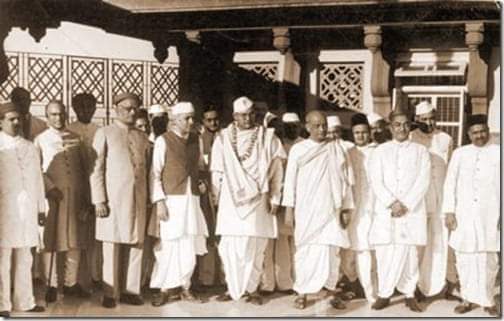
MAHATMA GANDHI IS NOT THE FATHER OF MY NATION
I agree that a Mahatma got us our freedom, but his name was Netaji Subhash Chandra Bose, not Mohandas Gandhi.
Very early in the childhood of each child of Bharat, it is taught that there is no better Mahatma than Gandhi.
I agree that a Mahatma got us our freedom, but his name was Netaji Subhash Chandra Bose, not Mohandas Gandhi.
Very early in the childhood of each child of Bharat, it is taught that there is no better Mahatma than Gandhi.

Kids are brainwashed with an image of Gandhi that is far from reality.
An old weak saint walking with a stick,who drove the mighty British away,with his so called weapon of Ahimsa.I mean, really ??
In the centre of Pic is the first Prime Minister of India that we never had.
An old weak saint walking with a stick,who drove the mighty British away,with his so called weapon of Ahimsa.I mean, really ??
In the centre of Pic is the first Prime Minister of India that we never had.

If that's the case then the freedom fighters like Subhash Bose, Bhagat Singh, Chandrashekhar Azaad, Lala Lajpat Rai, Sukhdev and many more died for nothing.
There deaths were all just a waste. Anyone who believes this today is a fool of highest order.
There deaths were all just a waste. Anyone who believes this today is a fool of highest order.
And to strengthen this thought process a bunch of lies were planted effortlessly by the liberals, pseudo-seculars , leftists and the bootlickers of Britishers like Nehru quite liberally since independence.
No wonder our History textbooks are full of this shit.
No wonder our History textbooks are full of this shit.

Lie#1: We have been taught that Rabindranath Tagore coined the name “Mahatma” for Gandhi.
But, did he ??
The answer is No. It was coined by some of his chamchas while he was in South Africa.
But, did he ??
The answer is No. It was coined by some of his chamchas while he was in South Africa.
The Britishers' farsightedness saw the benefit of having him and his Ahimsa theory to work in their favor, to curb the real armed revolution that was on a rise in India.
If not for this Mahatma, Bharat would have got her independence a few decades ago.
If not for this Mahatma, Bharat would have got her independence a few decades ago.
Armed revolution against the British was on the rise and was threatening to penetrate into the loyal British Indian army. This “Ahimsa pujari” was the perfect bait for the British to stem the tide and redirect it to a harmless game of “Satyagraha”. 

So,they stamped the epithet Mahatma on this man through official circular. An RTI application questioning who coined the term Mahatma met with a candid reply from Indian Council of Historical Research (ICHR)& National Archives of India(NAI) stating there were no official records.
The Britishers kept their Mahatma pampered in luxurious resorts and palaces (like Aga Khan palace) in the name of imprisoning him. And, the Mahatma paid them back generously by ensuring full support of Indians in their war efforts in both world war 1 & 2,..
..sending lacs of young Indian men to die on the Western front as cannon fodder.
Lie#2: India won its freedom without any war or bloodshed, only due to Gandhi &Nehru
Fact Check:A blatant lie which completely undermines ultimate sacrifice of 26000 soldiers of INA & Netaji Bose.
Lie#2: India won its freedom without any war or bloodshed, only due to Gandhi &Nehru
Fact Check:A blatant lie which completely undermines ultimate sacrifice of 26000 soldiers of INA & Netaji Bose.
It negates the sacrifices of the sepoys and freedom fighters of the 1857 uprising. It tries to wipe out the memories of thousands of freedom fighters who were shot or hanged or sent to the infamous cellular jail in the Andamans by the British. 

Eventually the British, bled almost dry in the two world wars and scared by the mutiny in its army and navy as an aftermath of the INA trials, decided to leave India, but only after putting it in the hands of its trusted agents - Jinnah, Nehru and Gandhi
Lie#3: Subhash Bose was a great fan of Gandhi and Nehru, hence he named his INA brigades after Gandhi, Nehru and Azad
Fact check: Subhas Bose did not name these brigades after Gandhi and Nehru. They already had these names before he took command of this army in Singapore.
Fact check: Subhas Bose did not name these brigades after Gandhi and Nehru. They already had these names before he took command of this army in Singapore.
Bose’s own daughter confirmed that his father had a “difficult” relationship with Gandhi, who sidelined and forced Bose to quit Congress.
It’s time we honor our real heroes and know our real History.
It’s time we honor our real heroes and know our real History.
Credit: Swarajya Magazine
• • •
Missing some Tweet in this thread? You can try to
force a refresh






























